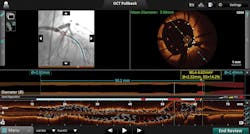St. Jude Medical demonstrates new findings from clinical trial using OCT technology
In a clinical trial, medical device maker St. Jude Medical (St. Paul, MN) has demonstrated that percutaneous coronary intervention (PCI) guided by optical coherence tomography (OCT) is superior to angiography in stent expansion and procedural success, and non-inferior to intravascular ultrasound (IVUS) guided-PCI in post-procedure minimal stent area (MSA).
Related: St. Jude Medical launches mobile OCT system in Europe and Japan
Results from the ILUMIEN III study were presented in the first Late Breaking Clinical Trial session of the Transcatheter Cardiovascular Therapeutics (TCT) Conference, held October 29 - November 2, 2016, in Washington, DC. The study, which enrolled 450 patients at 29 sites in eight countries, is a multicenter, prospective, randomized, controlled study comparing OCT-, IVUS-, and angiography-guided PCI outcomes.
The study findings confirm that OCT-guided PCI results in comparable MSA and stent expansion as IVUS-guided PCI; significantly greater stent expansion than angiography-guided PCI, with greater rates of procedural success; and is superior to IVUS-guided PCI at detecting predictors of major adverse events (major stent malapposition and dissection).
During PCI procedures, physicians use diagnostic imaging to make decisions related to stent sizing and to assess how to best keep the artery expanded to restore blood flow to the heart. A key factor in reducing stent failure is increasing the MSA and securing appropriate stent expansion during PCI to restore blood flow, a process commonly known as revascularization.
In the ILUMIEN III study, physicians employed the St. Jude Medical OPTIS Integrated and ILUMIEN OPTIS PCI optimization systems, along with the Dragonfly imaging catheters designed for high-resolution imaging, to assess vessel and lesion characteristics, size stents, and optimize stent placement in patients randomized to OCT-guided stent implantation.
Philip Ebeling, vice president and chief technology officer at St. Jude Medical, explains that OCT's resolution can detect predictors that can contribute to major adverse events and facilitate the treatment of those conditions to minimize the likelihood of their occurrence.
In 2017, St. Jude Medical plans to expand research that further demonstrates the long-term value of OCT. The company recently committed to sponsoring the ILUMIEN IV study, a global multicenter trial that will evaluate long-term outcomes in patients randomized to angiography-guided PCI alone vs. angiography and OCT-guided PCI, according to Dr. Gregg W. Stone, professor of medicine at Columbia University, director of cardiovascular research and education at the Center for Interventional Vascular Therapy at New York Presbyterian Hospital/Columbia University Medical Center, and co-director of medical research and Education at the Cardiovascular Research Foundation (CRF).
